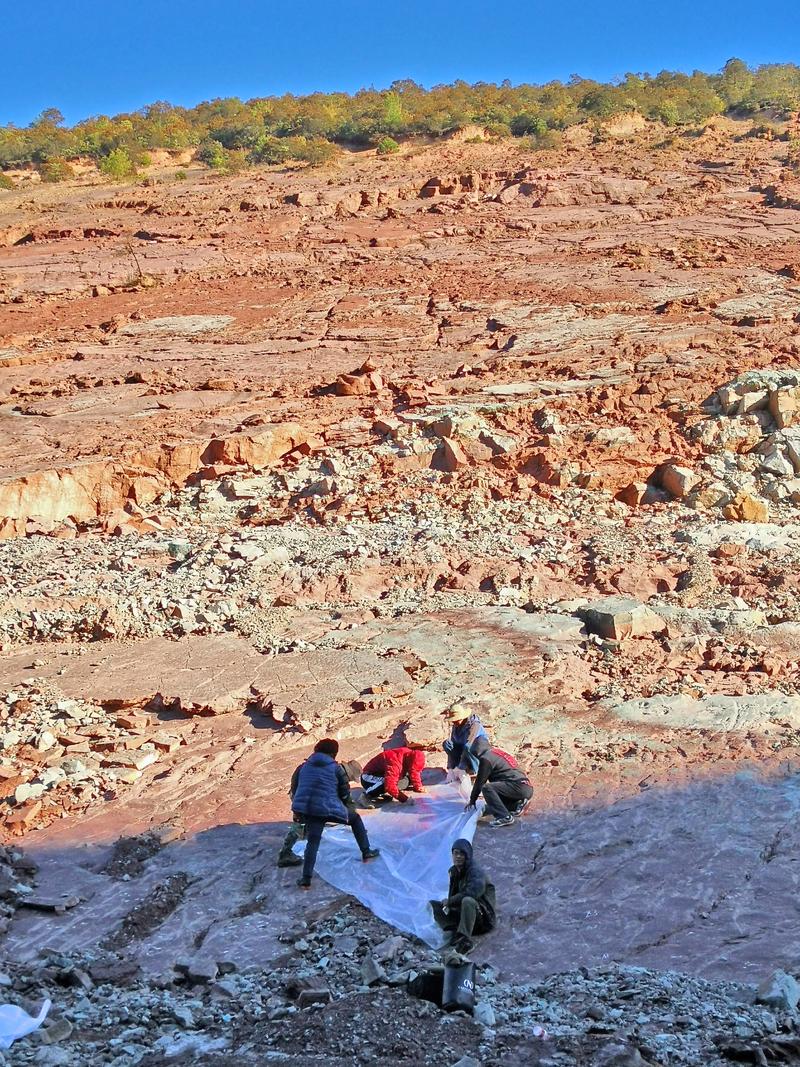 Scientists use a plastic sheet to outline a dinosaur tracksite in Zhaojue, Sichuan province. (PHOTO PROVIDED TO CHINA DAILY)
Scientists use a plastic sheet to outline a dinosaur tracksite in Zhaojue, Sichuan province. (PHOTO PROVIDED TO CHINA DAILY)
Paleontologists from home and abroad confirmed in a recently published essay that they have found the largest dinosaur tracksite ever discovered in China in Zhaojue, Sichuan province. The site covers an area of over 9,000 square meters, including at least 933 tracks.
The essay, co-written by Xing Lida, associate professor of China University of Geosciences, doctoral candidate Wang Miaoyan from CUG, Peng Guangzhao and Ye Yong, researchers from the Zigong Dinosaur Museum, Martin G. Lockley, professor at the University of Colorado Denver, and Hendrik Klein, dinosaur scholar from Germany, has been published on the international geological periodical Geoscience Frontiers.
Located in the middle of a copper mine in Zhaojue, these are arguably the most important tracksites in southwestern China, containing diverse sauropod, theropod, ornithopod and pterosaur track assemblages, researchers say in the essay.
The Zhaojue tracksites extend 1 kilometer from north to south, and span 0.5 km from east to west, consisting of four important track-bearing surfaces, numbered as I, II, IIN(north) and III, of which Zhaojue-I was first reported in 1994 and the others were sequentially discovered from 2012 to 2019.
The four tracksites contain a total of 1,928 tracks, covering an area of over 10,000 sq m, including the previously reported pterosaurs and theropod swim tracks.
Zhaojue-II experienced two exposures. In 2013, paleontologists found there the first dinosaur's swimming track discovered in China. The copper mining later increased the exposure of the tracksite so that it has been recognized as the largest dinosaur tracksite so far discovered in China.
From 2017 to 2019, paleontologists mapped the tracksite using drone technology, finding at least 933 recognizable dinosaur tracks, and the longest sauropod and ornithopoda tracks ever recorded in China, which measure 80 meters and 52 meters respectively. Some of the tracks exhibit the obvious change of the track makers' movement directions, providing behavior information.
The Zhaojue-II tracksite contains rich dinosaur tracks, including 61 trackways and seven isolated tracks, representing 68 track makers, of which 54 percent were ornithopoda.
Because the tracksites contain tracks of many different kinds of dinosaurs, it is important to the study of the living environment of dinosaurs in the Cretaceous Period, Peng says.
"There are also tracks that show dinosaur's special behavior, such as swimming or veering, which are helpful for the study of the behavior or the lifestyle of dinosaurs," he says.
Both Zhaojue-II and III tracksites contain paralleled ornithopoda trackways, suggesting the track makers' social or gregarious behavior.
Xing says there has been no Cretaceous dinosaur bone fossil discovered in Southern Sichuan Basin, so that the Zhaojue tracksites have provided great investigative samples for the study of dinosaur fauna in that region in the Cretaceous Period.
Over the last 30 years, however, due to quarrying, erosion or collapse during copper mining, the tracksites have been continuously exposed and damaged.
The local government shut down the copper mine for good in 2018, according to a report by West China Metropolis Daily.
However, concrete plans to protect the Zhaojue tracksites are still lacking, says Ebi Jiefang, former director of Relic Management Institute of Zhaojue county.
"The tracks that are clear when first exposed have been weathered," he says, adding that the dinosaur tracksites are located at more than 2,000 meters above the sea level, which has worsened the weathering.
"Since these tracks are so important for geological studies, related departments should cooperate to come up with protective plans as soon as possible," he says.


